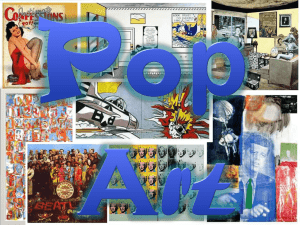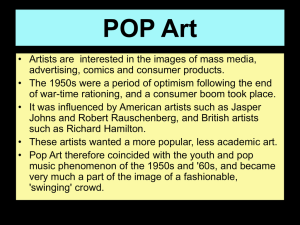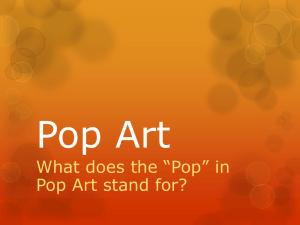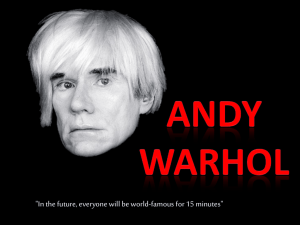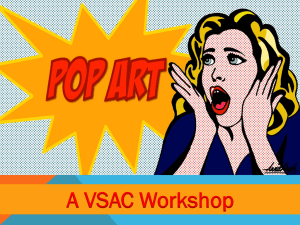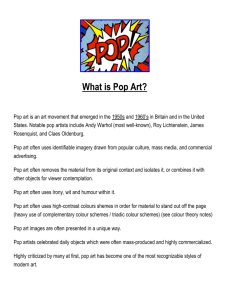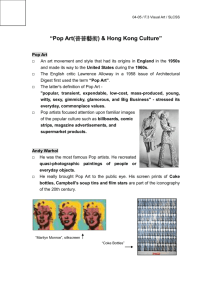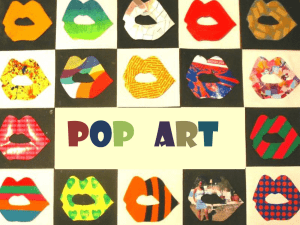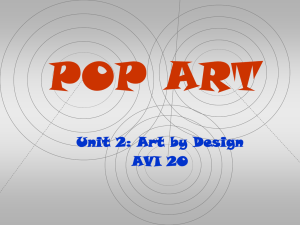Pop Art - artisFUN2do
advertisement
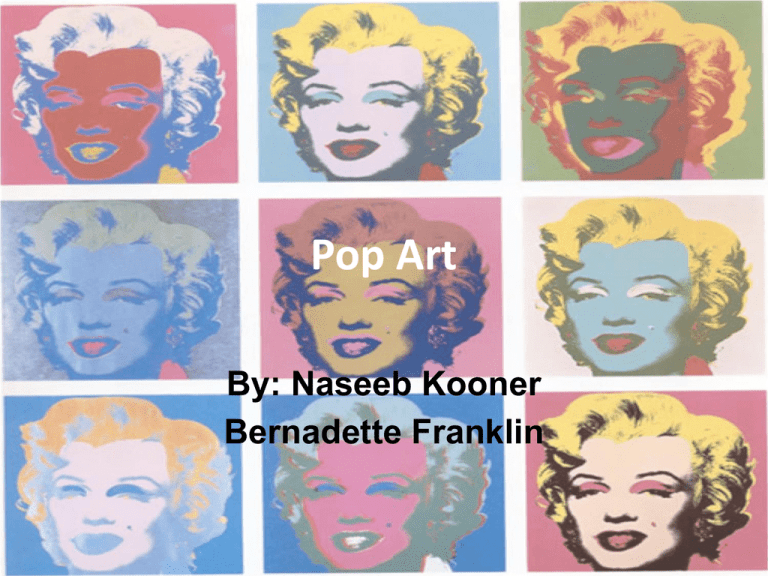
Pop Art By: Naseeb Kooner Bernadette Franklin What is Pop Art? • Pop Art is art that is based on popular culture and the mass media – Reflects current values of society/culture – Uses images borrowed from advertising, photography, comic strips and other mass media sources • Pop Art is influenced from two dimensional images • Mechanical Production – Screen Printing – Machine Produced – Emphasis on Mass Production Where Did Pop Art Come From? • Visual art movement that began mid 1950s in Britain, late 1950s in the U.S. • The Independent Group founded in London in 1952 was precursor to the Pop Art Movement • Lawrence Alloway- “The Arts and the Mass Media” – Popular Mass Culture= led to term Pop Art History Of Pop Art • 1950’s! – Period of optimism – Consumer boom – Products mass marketed, advertised • Independent Group – Aimed at symbols/ images from media • Coincided with youth and pop music phenomenon Influences • Pop art widely interpreted as reversal or reaction to Abstract Expressionism – emotional expression with particular emphasis on the spontaneous act • Drew upon DADAist elements – Movement that mocked artistic and social conventions. Emphasized the illogical and absurd. – Favored montage, collage and the readymade Characteristics • Brings back the subject • Questions art as a commodity and as a unique art form • Everyday subject matter • Marked by – – – – Clear lines Bold colors Sharp paintwork Clear representations of symbols, objects, and people common in pop culture Techniques • Central focus= commercial art – Styles of popular culture and the mass media – News paper, comics, advertising, consumer goods – Mass production – Low cost – Expendable – "Like a joke without humor, told over and over again until it begins to sound like a threat... Advertising art which advertises itself as art that hates advertising.” Harold Rosenberg Andy Warhol • Born August 8th 1928 • One of the most influential artists on the 20th century • Famous for – Avant-guard pop art paintings and screen printings Campbell’s Soup Can 1964 Andy Warhol Silkscreen on Canvas Marilyn Monroe 1967 Andy Warhol Screenprint on white paper Peel Slowly and See Andy Warhol 1967 Roy Lichtenstein • Born October 27, 1923 • Began first pop paintings using cartoon images and techniques derived from the appearance of commercial printing – Included use of advertising suggesting consumerism that reflected home life The Drowning Girl Roy Lichtenstein 1963 Ohhh…Alright… 1964 Roy Lichtenstein Whaam! Roy Lichtenstein 1963 Clay Oldenburg • Born January 28, 1929 • Known for his public art installations – Featured very large replicas (sculptures) of everyday objects • Sculptures often involved interactive capabilities – Tube of lipstick Spoon Bridge and Cherry Claes Oldenburg 1985 Big Sweep Claes Oldenburg Apple Core Claes Oldenburg Jasper Johns • Born May 15, 1930 • Early works composed using simple schemes of flags, maps, letters, targets and numbers • Made use of classical iconography • Seeking to create meaning through the use of symbols Target with Four Faces Jasper Johns 1955 False Start Jasper Johns 1959 Flag Jasper Johns 1954 Summary • Characterized by bold, simple, everyday imagery, and vibrant block colors. • Influenced by abstract expressionism and DADAism • Reflects pop culture and consumerism • Easy to understand, recognize and interpret • Major artists: Andy Warhol, Roy Lichtenstein the end
